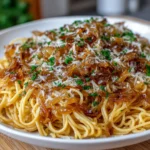Description
Make this rich Caramelized Onion Pasta! Sweet, savory onions in a creamy vegan sauce, simple, comforting, and full of deep flavor
Ingredients
For the Caramelized Onions (The Heart of the Dish):
-
3-4 Large Yellow Onions (about 2.5-3 lbs total): Yellow onions are ideal for their perfect balance of sugar and astringency. Sweet onions like Vidalia can be used but may caramelize faster.
-
3-4 tablespoons Unsalted Butter & 2 tablespoons Olive Oil: The combination of butter (for flavor) and oil (for a higher smoke point) is perfect for the long cooking process.
-
1 teaspoon Salt: Essential for drawing out moisture from the onions and seasoning them throughout.
-
1 teaspoon Sugar (optional but recommended): A small pinch can help kickstart the caramelization process, especially for beginners.
-
2-4 tablespoons Water, Broth, or Dry White Wine: For deglazing the pan and preventing the onions from sticking or burning.
For the Pasta & Sauce Base:
-
1 lb Long Pasta: Tagliatelle, pappardelle, or fettuccine are ideal as their broad, flat surfaces beautifully catch the jammy onions. Linguine or bucatini also work very well.
-
4-5 cloves Garlic, minced: Added towards the end of caramelization to infuse its flavor without burning.
-
2 tablespoons Tomato Paste: This is a secret weapon for adding a layer of rich, concentrated umami and a touch of acidity.
-
1/2 cup Dry White Wine (such as Sauvignon Blanc or Pinot Grigio): This deglazes the pan and adds a bright, complex acidity that balances the sweetness.
-
1 1/2 cups Pasta Water: This is non-negotiable. The starchy, salty water is the key to creating a silky, emulsified sauce that clings to the pasta.
-
1/2 cup freshly grated Parmesan or Pecorino Romano Cheese, plus more for serving: Pecorino adds a sharper, saltier bite, while Parmesan is nuttier.
-
Fresh Thyme leaves (from 4-5 sprigs) or 1/2 teaspoon dried thyme: Thyme and onion are a classic, heavenly pairing.
For Garnish and Finishing:
-
Freshly chopped Italian Parsley
-
Extra grated Parmesan or Pecorino Cheese
-
Freshly cracked Black Pepper
-
A drizzle of high-quality Extra Virgin Olive Oil
Instructions
Step 1: Slice the Onions Correctly
This is a crucial first step. Halve the onions from root to stem end. Peel them, then lay them flat on your cutting board. Slice them evenly from root to stem end into 1/4-inch thick slices (or a little thinner). Slicing along this grain helps the onions hold their texture better during the long cooking process, resulting in a silky, jammy consistency rather than a complete mush.
Step 2: The Slow Caramelization (The Most Important Step)
In a large, heavy-bottomed Dutch oven or skillet (a wide surface area is helpful), melt the butter and olive oil over medium-low heat. Add all the sliced onions and the salt. Toss to coat in the fat. They will be a towering mound, but they will wilt down significantly. Cook, stirring occasionally, for about 10 minutes until they have softened and started to become translucent. Now, the patience begins. Reduce the heat to low. Continue to cook, stirring every 5-10 minutes, scraping the bottom of the pan. If the onions seem to be sticking or cooking too quickly in spots, add a tablespoon or two of water and lower the heat. This process will take 45 to 60 minutes, minimum. Do not rush it. You are waiting for them to turn a deep, golden, amber brown and become incredibly soft and sweet.
Step 3: Develop the Flavor Base
Once the onions are deeply caramelized, add the minced garlic and fresh thyme. Cook for just 1 minute until fragrant. Push the onions to one side of the pan and add the tomato paste to the cleared spot. Let it cook and “toast” for 30-60 seconds, then stir it into the onions. This deepens its flavor significantly.
Step 4: Deglaze and Build the Sauce
Pour in the white wine to deglaze the pan. Scrape up any browned bits (the fond) from the bottom of the pan—this is pure flavor. Let the wine simmer until it is mostly reduced. At this point, start cooking your pasta in a large pot of well-salted water until it is just 1-2 minutes shy of al dente.
Step 5: The Emulsification – Creating the Sauce
Before draining the pasta, carefully scoop out 1 1/2 cups of the starchy pasta water. Add about 1 cup of this water directly to the caramelized onion mixture. Bring it to a gentle simmer, stirring. It will look a bit watery at first. The magic is about to happen.
Step 6: Combine Pasta and Sauce
Transfer the drained, undercooked pasta directly into the sauce. Using tongs, toss and swirl the pasta continuously, adding more pasta water as needed. The starch from the water will emulsify with the fats and the onion jam, creating a glossy, luxurious sauce that coats every strand. Cook for 1-2 minutes, until the pasta is perfectly al dente and has absorbed the sauce.
Step 7: The Final Enrichment – Mantecatura
Remove the pan from the heat. This is critical. Adding cheese over direct heat can cause it to become greasy and clumpy. Now, stir in the freshly grated Parmesan or Pecorino cheese and a generous amount of black pepper. Toss vigorously until the cheese has melted into the sauce, creating a final layer of richness and saltiness.
Notes
-
Large, heavy-bottomed Dutch Oven or Skillet
-
Large Pot for boiling pasta
-
Sharp Chef’s Knife and Cutting Board
-
Tongs for tossing the pasta
-
Measuring Spoons and Cups
-
Grater for cheese
- Prep Time: 15 minutes
- Category: Dinner
- Cuisine: American
Nutrition
- Calories: 650 kcal
- Sugar: 15g
- Sodium: 700 mg
- Fat: 22 g
- Carbohydrates: 90g
- Fiber: 7 g
- Protein: 22g
